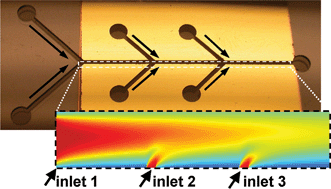Active control of the depletion boundary layers in microfluidic electrochemical reactors†
Abstract
In this paper, we describe three methods to improve the performance of pressure-driven laminar flow-based microreactors by manipulating reaction-depletion boundary layers to overcome mass transfer limitations at reactive surfaces on the walls, such as electrodes. The transport rate of the reactants to the reactive surfaces is enhanced by (i) removing the depleted zone through multiple periodically-placed outlets; (ii) adding fresh reactants through multiple periodically-placed inlets along the reactive surface; or (iii) producing a spiraling, transverse flow through the integration of herringbone ridges along the channel walls. For approaches (i) and (ii), the network of microfluidic channels needs to be designed such that under the operating conditions used the right amount of boundary layer at each outlet or inlet is removed or replenished, respectively. Here, we report a set of design rules, derived with the help of a fluidic resistance circuit model, to aid in the design of appropriate microfluidic networks. Also, the actual enhancement of the performance of the electrochemical microreactor, i.e. chemical conversion efficiency, using multiple inlets, multiple outlets, or herringbone ridges is reported.


 Please wait while we load your content...
Please wait while we load your content...